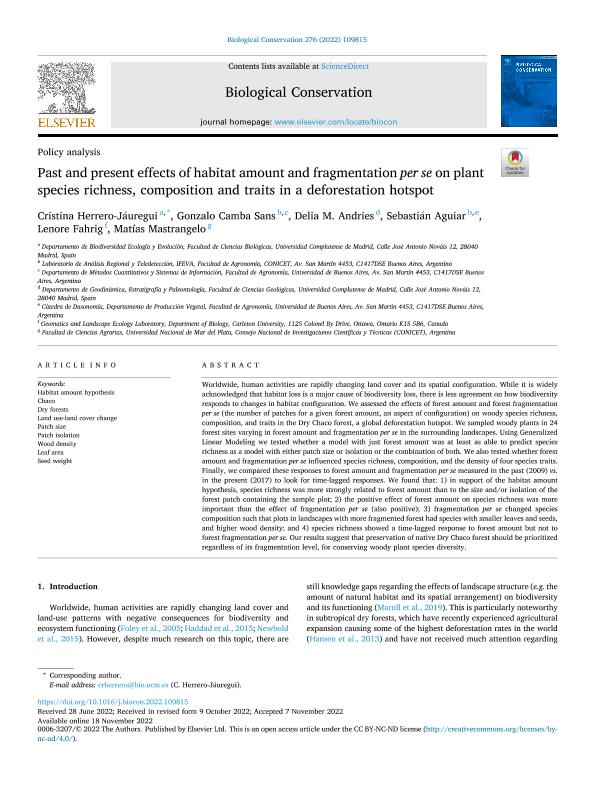Artículo
Past and present effects of habitat amount and fragmentation per se on plant species richness, composition and traits in a deforestation hotspot
Herrero Jáuregui, Cristina; Camba Sans, Gonzalo Hernán ; Andries, Delia M.; Aguiar, Sebastián
; Andries, Delia M.; Aguiar, Sebastián ; Fahrig, Lenore; Mastrangelo, Matias Enrique
; Fahrig, Lenore; Mastrangelo, Matias Enrique
 ; Andries, Delia M.; Aguiar, Sebastián
; Andries, Delia M.; Aguiar, Sebastián ; Fahrig, Lenore; Mastrangelo, Matias Enrique
; Fahrig, Lenore; Mastrangelo, Matias Enrique
Fecha de publicación:
12/2022
Editorial:
Elsevier
Revista:
Biological Conservation
ISSN:
0006-3207
Idioma:
Inglés
Tipo de recurso:
Artículo publicado
Clasificación temática:
Resumen
Worldwide, human activities are rapidly changing land cover and its spatial configuration. While it is widely acknowledged that habitat loss is a major cause of biodiversity loss, there is less agreement on how biodiversity responds to changes in habitat configuration. We assessed the effects of forest amount and forest fragmentation per se (the number of patches for a given forest amount, an aspect of configuration) on woody species richness, composition, and traits in the Dry Chaco forest, a global deforestation hotspot. We sampled woody plants in 24 forest sites varying in forest amount and fragmentation per se in the surrounding landscapes. Using Generalized Linear Modeling we tested whether a model with just forest amount was at least as able to predict species richness as a model with either patch size or isolation or the combination of both. We also tested whether forest amount and fragmentation per se influenced species richness, composition, and the density of four species traits. Finally, we compared these responses to forest amount and fragmentation per se measured in the past (2009) vs. in the present (2017) to look for time-lagged responses. We found that: 1) in support of the habitat amount hypothesis, species richness was more strongly related to forest amount than to the size and/or isolation of the forest patch containing the sample plot; 2) the positive effect of forest amount on species richness was more important than the effect of fragmentation per se (also positive); 3) fragmentation per se changed species composition such that plots in landscapes with more fragmented forest had species with smaller leaves and seeds, and higher wood density; and 4) species richness showed a time-lagged response to forest amount but not to forest fragmentation per se. Our results suggest that preservation of native Dry Chaco forest should be prioritized regardless of its fragmentation level, for conserving woody plant species diversity.
Archivos asociados
Licencia
Identificadores
Colecciones
Articulos(IFEVA)
Articulos de INST.D/INV.FISIOLOGICAS Y ECO.VINCULADAS A L/AGRIC
Articulos de INST.D/INV.FISIOLOGICAS Y ECO.VINCULADAS A L/AGRIC
Citación
Herrero Jáuregui, Cristina; Camba Sans, Gonzalo Hernán; Andries, Delia M.; Aguiar, Sebastián; Fahrig, Lenore; et al.; Past and present effects of habitat amount and fragmentation per se on plant species richness, composition and traits in a deforestation hotspot; Elsevier; Biological Conservation; 276; 12-2022; 1-14
Compartir
Altmétricas



